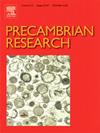Igneous apatite geochemistry indicates early cratonization of continents
IF 3.2
2区 地球科学
Q2 GEOSCIENCES, MULTIDISCIPLINARY
引用次数: 0
Abstract
Processes and mechanisms accounting for the stabilization of Archean (4.0–2.5 Ga) continental crust remain a matter of debate. Over the last decades, major efforts have been made to determine the chemical and isotopic composition of rocks belonging to the Tonalite-Trondhjemite-Granodiorite (TTG) suite, i.e. those forming the bulk of Archean continental crust, as well as late-Archean sanukitoids, the typical marker of cratonization. The extensive use of zircon elemental and isotopic signatures has indisputably been an unrivalled source of information; yet it has also biased interpretations through the prism of a single mineral, hence not reflecting the whole geological history of these magmas. To extend our understanding of early continent stabilization, a pivotal aspect of Earth’s evolution, a fresh perspective is necessary. Here, we present in-situ analyses of igneous apatite, Ca5(PO4)3(OH,Cl,F), from Archean granitoids exposed in the eastern Kaapvaal craton for major/trace elements and U–Pb/Sr isotopes. The trace element signatures of these apatite crystals, with a clear enrichment in LREE and an elevated LREE/HREE, resemble that of apatite from sanukitoids and Phanerozoic I-type granites, a signature which can be blurred at the whole-rock scale. We interpret this signature as indicating that the studied granitoids are formed via interaction between (i) a TTG melt, formed via partial melting of a subducting oceanic crust and (ii) a mantle component, causing chemical depletion of the mantle domain involved and thus production of long-lived and stable lithospheric keels pivotal in the long-term preservation of Archean lithosphere at the Earth’s surface. Therefore, the identification of this signature—in igneous apatite from Paleo to Meso-Archean TTGs of the eastern Kaapvaal—indicates an early onset of cratonization in this region.
火成岩磷灰石地球化学特征表明大陆早克拉通化
太古代(4.0-2.5 Ga)大陆地壳稳定的过程和机制仍然是一个有争议的问题。在过去的几十年里,人们已经做出了主要的努力,以确定属于Tonalite-Trondhjemite-Granodiorite (TTG)套的岩石的化学和同位素组成,即那些形成了太古宙大陆地壳的大部分,以及晚太古宙的sanukitoids,克拉通化的典型标志。锆石元素和同位素特征的广泛使用无疑是一种无与伦比的信息来源;然而,它也通过单一矿物的棱镜进行了有偏见的解释,因此不能反映这些岩浆的整个地质历史。为了扩展我们对早期大陆稳定的理解,这是地球演化的一个关键方面,一个新的视角是必要的。本文对Kaapvaal克拉通东部太古代花岗岩中的火成岩磷灰石Ca5(PO4)3(OH,Cl,F)进行了主微量元素和U-Pb /Sr同位素的原位分析。这些磷灰石晶体的微量元素特征明显富集轻稀土元素,轻稀土/重稀土元素比值升高,与sanukitoids和显生宙i型花岗岩的磷灰石相似,但在全岩尺度上具有模糊特征。我们将这一特征解释为表明所研究的花岗岩类是通过(i) TTG熔体(由俯冲海洋地壳的部分熔融形成)和(ii)地幔成分的相互作用形成的,这些成分导致了地幔域的化学耗散,从而产生了长期稳定的岩石圈龙骨,这对地球表面太古宙岩石圈的长期保存至关重要。因此,在卡普瓦尔东部古太古代至中太古代火成岩磷灰石中发现这一特征,表明该地区克拉通化发生得较早。
本文章由计算机程序翻译,如有差异,请以英文原文为准。
求助全文
约1分钟内获得全文
求助全文
来源期刊

Precambrian Research
地学-地球科学综合
CiteScore
7.20
自引率
28.90%
发文量
325
审稿时长
12 months
期刊介绍:
Precambrian Research publishes studies on all aspects of the early stages of the composition, structure and evolution of the Earth and its planetary neighbours. With a focus on process-oriented and comparative studies, it covers, but is not restricted to, subjects such as:
(1) Chemical, biological, biochemical and cosmochemical evolution; the origin of life; the evolution of the oceans and atmosphere; the early fossil record; palaeobiology;
(2) Geochronology and isotope and elemental geochemistry;
(3) Precambrian mineral deposits;
(4) Geophysical aspects of the early Earth and Precambrian terrains;
(5) Nature, formation and evolution of the Precambrian lithosphere and mantle including magmatic, depositional, metamorphic and tectonic processes.
In addition, the editors particularly welcome integrated process-oriented studies that involve a combination of the above fields and comparative studies that demonstrate the effect of Precambrian evolution on Phanerozoic earth system processes.
Regional and localised studies of Precambrian phenomena are considered appropriate only when the detail and quality allow illustration of a wider process, or when significant gaps in basic knowledge of a particular area can be filled.
 求助内容:
求助内容: 应助结果提醒方式:
应助结果提醒方式:


